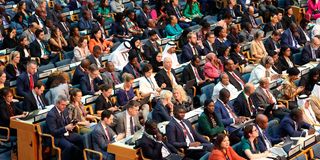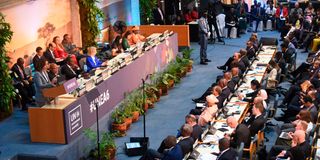UNEA-6: Countries reject solar engineering as way to combat climate change

Delegates attending the opening of the sixth session of the United Nations Environment Assembly (UNEA-6) at the United Nations Environment Programme (UNEP) headquarters in Nairobi on February 26,2024.
What you need to know:
- Some of the resolutions that were passed on Friday March 1 include improving air quality globally, doing away with highly hazardous pests and chemicals.
- Others were sound management of chemicals and waste, and strengthening water policies, among others.
- Delegates opposed solar engineering, also known as solar radiation modification.

United Nations Environment Assembly (UNEA) President Leila Benali delivering her remarks at UNEP headquarters in Nairobi.
Delegates attending the sixth session of the United Nations Environment Assembly (UNEA 6) have adopted 15 resolutions, two draft decisions, and one ministerial declaration.
The culmination of the assembly provides the world with new policies and standards that will be implemented by countries for a better environment.
Leila Benali, UNEA 6 president said that this UNEA is the most inclusive in history and that the ministerial declaration that was passed represents great urgency for our planet urging environment ministers around the world to uphold several actions.
Some of the resolutions that were passed on Friday March 1 include improving air quality globally, doing away with highly hazardous pests and chemicals, sound management of chemicals and waste, and strengthening water policies, among others.
However, one of the resolutions that UNEP executive director Inger Andersen had hoped would be passed was withdrawn in the early hours of the final day for fear of unknown impacts on the environment should it be adopted.
The resolution is on solar engineering, also known as solar radiation modification and it was strongly opposed by delegations, especially those from Africa.
Speaking at a press conference yesterday, Ms Andersen said that the withdrawal shows that we still need to have a further understanding of the technology.

United Nations Environment Programme Executive Director Inger Andersen addressing journalists during a press briefing on the 6th Session of the United Nations Environmental Assembly (UNEA-6.
“Many countries and people may not have fully internalised this highly complex technology. It made it very clear that our role as UNEP is to keep our eyes on the horizon and see what new waves may be hitting our environmental shores and assess their impact before we have a global conversation on deployment,” she said.
“Many times, UNEP has been brought in when technology has already done damage like the use of lead in petrol, or the use of mercury. This is why it should be better, in our view, to have a global conversation,” she added.
According to Havard’s Geoengineering Program, solar engineering is a technology that creates a blanket between Earth and the sun thereby bouncing back the sun’s rays into space instead of allowing it to penetrate the earth's surface in a bid to make the planet cooler.
“Solar geoengineering does not address the root cause of climate change. It instead aims to break the link from concentrations to temperatures, thereby reducing some climate damages,” explains a Havard report.
The withdrawal precedes earlier precautions on the approach to geoengineering by other UN bodies, especially the Convention on Biological Diversity (CBD) which argued that biodiversity species will be lost should countries adopt it.
However, some countries that were already investing in geoengineering studies, opposed the mention of precaution in the resolution and proposed that there needs to be a scientific study on the “risks and benefits” of solar geoengineering technologies.

Chairman of the Environment Authority of Oman Abdullah Bin Ali Amri delivering his acceptance speech at the closing session of the 6th United Nations Environment Assembly (UNEA-6) at the UNEP headquarters in Nairobi on March 1, 2024 where he was elected the 7th UNEA President.
Mary Church, a Senior Geoengineering Campaign manager at Center for International Environmental Law (CIEL) said yesterday that the vocal opposition sends a powerful message underscoring a broad commitment to upholding established norms of international environmental law.
“Solar Radiation Modification (SRM) technologies are dangerous and do not have any role to play in our common future.
These technologies cannot tackle the root causes of the climate crisis and would instead enable major polluters to delay the urgent need to phase out fossil fuels,” she said.
“Solar geoengineering is a dangerous techno-fix brought by researchers and powerful actors in the same Northern countries that have caused climate change: it's about adding more pollution to an over-polluted world.
At UNEA-6, precaution prevailed over the attempts to legitimate this risky and unfair technology,” explained Silvia Ribeiro, ETC Group Latin America Director.
It is through such multilateral processes that agreements are either upheld or shot down. Rightfully so because this year’s UNEA focused on ensuring countries amicably embrace Multilateral Environment Agreements (MEAs) so that issues affecting our planet can be dealt with.
In an exclusive interview with Nation, UNEP’s Director, Law Division Patricia Kameri-Mbote, explained that MEAs occur when countries come to the table, negotiate, and agree on different environmental issues. After which, these issues become set standards or benchmarks that countries follow.





